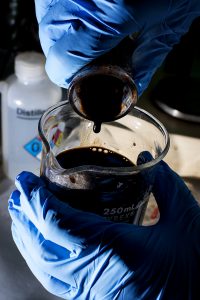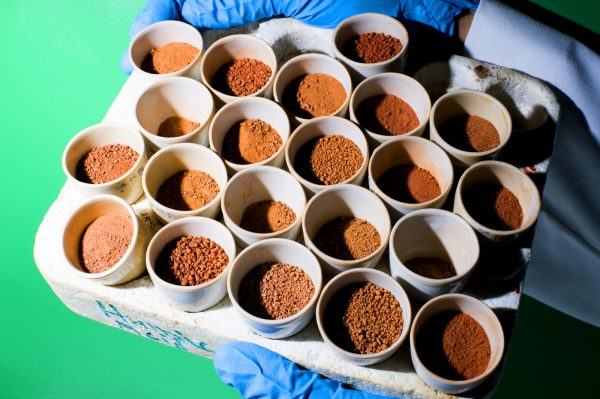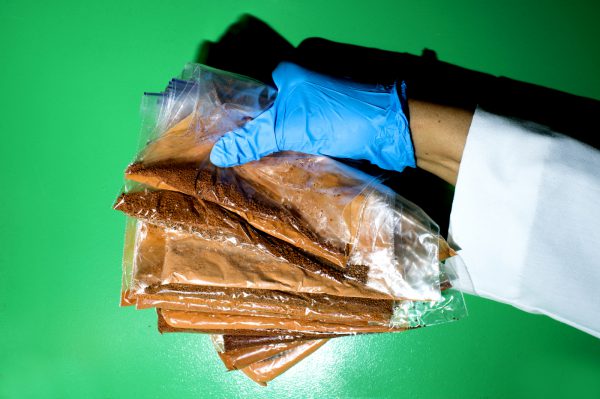Ghabbour, a soil expert, said the reason organic soil can hold more carbon is because it has higher concentrations of humic acids. These are substances in the soil that give it the brown color we see in our backyards, as opposed to the sandy-blonde or ashy-red varieties. Humic acids bind to soil, making it more fertile, allowing it to retain water, and assisting plants in absorbing nutrients. It also captures carbon—a greenhouse gas that contributes to climate change—from the air and stores it long term.
 Dr. Ghabbour pours humid acid gel from soil. Photo by Matthew Modoono/NEU
Dr. Ghabbour pours humid acid gel from soil. Photo by Matthew Modoono/NEU
In collaboration with the Organic Center, a nonprofit research and education organization, and working with citizen scientists across the nation, Ghabbour and Davies collected and analyzed 659 organic soil samples from 39 states and 728 conventional soil samples from all 48 contiguous states. They found that organic soil samples have 44 percent higher levels of humic acids than conventional soil samples.
The findings, published Sunday in Advances in Agronomy, have implications for the climate and overall health of the planet, they said. “It’s also consistent with the mantra of Northeastern—to promote sustainability and security,” said Davies, Matthews Distinguished University Professor of Chemistry. “Food has to be safe, and you have to preserve the means to grow food.”
This is the first study of its kind, Ghabbour said. She and Davies developed a novel method to extract humic acids from soil samples—a process that takes nine days to complete. They described the method in the paper with the hope that other labs around the world will replicate their findings.
Ghabbour has been studying humic acid since 1982. She joined Northeastern in 1993, when she and Davies built the Humic Acid Research Group. “She’s the leading expert on the subject,” Davies said. One of the group’s early discoveries was finding humic acid molecules in a live plant. Up to that point, scientists had thought it came only from decomposing plants.
 Dr. Ghabbour shows mineral residue from the combustion of soil. Photo by Matthew Modoono/Northeastern University
Dr. Ghabbour shows mineral residue from the combustion of soil. Photo by Matthew Modoono/Northeastern University
Humic acid is still shrouded in mystery, even today. “We hope to be able to find a chemical structure from the spectrum of humic acids,” Ghabbour said. “We’ve only suggested model structures at this point.
“Nobody knows the structure of it,” Ghabbour continued. “Humic acids also capture carbon dioxide—a greenhouse gas in the form of organic substances that contributes to climate change.”
 Dr. Ghabbour shows mineral residue from the combustion of soil at Northeastern University. Photo by Matthew Modoono/Northeastern University
Dr. Ghabbour shows mineral residue from the combustion of soil at Northeastern University. Photo by Matthew Modoono/Northeastern University
Researchers also don’t know why organic soil has higher concentrations of humic acid than conventional soil. But they have a theory.
“One of the reasons could be that feeding soils with fertilizers kills this material,” Davies said. Humic acids act as natural fertilizers, selectively binding to toxins and releasing nutrients in the soil. The synthetic alternative to humic acids is man-made “plant food” like Miracle-Gro and other fertilizers. But while these products can be effective, “It’s not building soil. It’s giving plants quick food” Ghabbour said. “The humic acids in soil are healthier for the soil long term.”

 Elham Ghabbour, Principal Research Scientist Department Chemistry & Chemical Biology and Geoffrey Davies, Matthews Distinguished University Professor, work in Hurtig Hall at Northeastern University on Sept. 27, 2017. Photo by Matthew Modoono/Northeastern University
Elham Ghabbour, Principal Research Scientist Department Chemistry & Chemical Biology and Geoffrey Davies, Matthews Distinguished University Professor, work in Hurtig Hall at Northeastern University on Sept. 27, 2017. Photo by Matthew Modoono/Northeastern University

